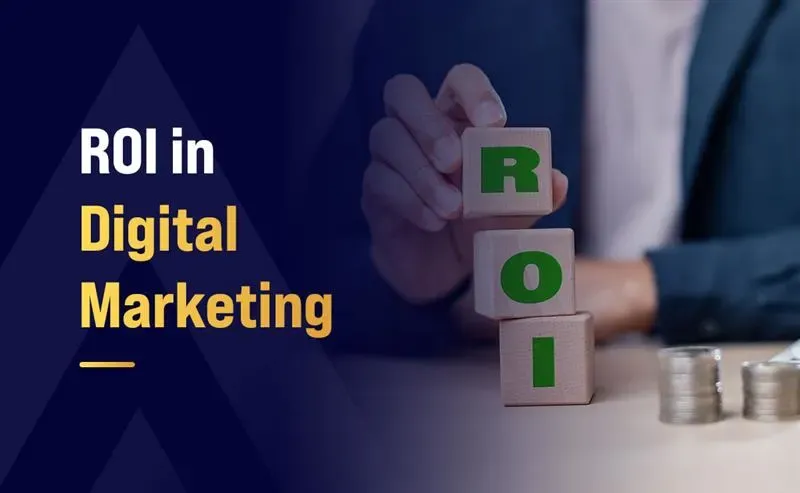Measuring ROI in digital marketing is essential if you want to understand how well your campaigns are performing. You might be spending money on ads, content, emails, or social media, but are you actually getting value in return? Knowing your marketing campaign ROI helps you make smarter decisions, save money, and improve your future results.
In this blog, we’ll break down how to measure ROI in digital marketing in simple words. From important metrics to easy calculation steps and tools you can use, this guide will help you understand everything you need to know about measuring marketing effectiveness.
Understanding ROI in Digital Marketing: What It Really Means
ROI stands for Return on Investment. In digital marketing, ROI tells you how much profit (or loss) your marketing campaign brings in compared to what you spent.
Simple ROI Formula:
ROI = (Revenue – Cost) / Cost × 100
For example, if you spent ₹10,000 on a Facebook ad and earned ₹15,000 in sales from it:
ROI = (15,000 – 10,000) / 10,000 × 100 = 50%
This means you earned a 50% return on your marketing investment.
Why Is ROI Important?
-
Helps you understand if a campaign is profitable
-
Shows which marketing channels work best
-
Helps you improve future planning and budgeting
-
Proves the value of marketing to business owners or managers
Key Metrics to Track for Accurate ROI Calculation
To measure ROI correctly, you must track the right digital marketing metrics. These key metrics give you a clear picture of campaign success:
1. Cost Per Click (CPC)
How much you pay every time someone clicks on your ad.
2. Click-Through Rate (CTR)
Percentage of people who clicked on your ad or email after seeing it.
3. Conversion Rate
How many visitors took the desired action—like buying a product or signing up.
4. Customer Acquisition Cost (CAC)
The cost of gaining one customer.
5. Customer Lifetime Value (CLTV)
The total revenue you earn from one customer during their lifetime.
6. Revenue Generated
The total money you earned from a campaign.
Tracking these will help you see how effective your campaign is and how it contributes to your ROI.
How to Set Clear Goals and KPIs for Your Marketing Campaigns
Before measuring ROI, you must set clear goals. Without goals, you won’t know what success looks like.
How to Set Good Marketing Goals?
Use the SMART method:
-
Specific: What exactly do you want to achieve?
-
Measurable: Can you measure the result?
-
Achievable: Is it realistic?
-
Relevant: Does it align with your business?
-
Time-bound: Do you have a deadline?
Examples of Marketing Campaign KPIs (Key Performance Indicators)
-
Increase website traffic by 30% in 3 months
-
Get 100 new leads through a landing page
-
Reduce customer acquisition cost by 20%
-
Achieve a 5% conversion rate on Google Ads
Clear KPIs help you track performance and measure ROI more accurately.
The Role of Attribution Models in Measuring ROI
Not every customer buys immediately. Sometimes, they see your ad, visit your website later, read a blog post, and then make a purchase. So how do you know which channel or step deserves the credit?
That’s where attribution models come in.
Common Attribution Models:
-
First-Click Attribution
Gives credit to the first channel the customer interacted with. -
Last-Click Attribution
Gives credit to the final action that led to conversion. -
Linear Attribution
Distributes equal credit across all touchpoints. -
Time-Decay Attribution
Gives more credit to actions closer to the conversion. -
Position-Based Attribution
Gives 40% credit to first and last interactions, and 20% to the middle ones.
Choosing the right model is important to measure marketing campaign ROI accurately, especially if you run multi-channel campaigns (like email, Google Ads, social media, etc.).
Tools and Software for Tracking ROI in Digital Marketing
Using the right tools makes measuring marketing effectiveness much easier. Here are some helpful platforms:
1. Google Analytics
Track website traffic, goals, conversions, and user behavior.
2. HubSpot
A full marketing platform that tracks leads, sales, and customer journeys.
3. Facebook Ads Manager
Shows cost, reach, conversions, and ROAS (Return on Ad Spend) for Facebook campaigns.
4. Google Ads Dashboard
Helps track keyword performance, clicks, conversions, and cost per conversion.
5. SEMrush or Ahrefs
Measure SEO performance, traffic growth, and content ROI.
6. CRM Tools (like Zoho or Salesforce)
Track leads, sales pipelines, and customer data to understand revenue sources.
These tools help marketers analyze campaign data in real-time and measure ROI with accuracy.
How to Calculate ROI: Step-by-Step Guide
Here’s a quick step-by-step guide to help you calculate ROI in digital marketing.
Step 1: Track Your Total Marketing Costs
Include ad spend, content creation cost, tools, agency fees, etc.
Step 2: Track Revenue Generated
Use CRM or e-commerce platforms to track how much money the campaign brought in.
Step 3: Apply the ROI Formula
Use the simple formula:
ROI = (Revenue – Cost) / Cost × 100
Example:
-
Campaign Cost: ₹20,000
-
Revenue from Campaign: ₹50,000
ROI = (50,000 – 20,000) / 20,000 × 100 = 150%
This means the campaign earned a 150% return on investment. That’s a great result!
Interpreting ROI Data: Making Data-Driven Decisions for Future Campaigns
Once you know your ROI, it’s time to use that data to improve future marketing efforts. Numbers alone aren’t enough—you must know how to interpret them.
Questions to Ask:
-
Which channel brought in the most conversions?
-
Which ad copy or landing page performed best?
-
Did the campaign meet its goals and KPIs?
-
What can be improved next time?
Use ROI Data To:
-
Optimize ad budgets by investing in high-ROI channels
-
Stop campaigns with low returns
-
Test new strategies and A/B tests
-
Improve messaging, targeting, and timing
Making data-driven decisions based on ROI results will help you grow faster and spend smarter in the future.
Final Thoughts: Why ROI Measurement Matters More Than Ever
In today’s competitive market, every rupee spent on digital marketing must bring results. Measuring ROI in digital marketing is not just about numbers—it’s about understanding what works and what doesn’t.
From setting clear goals, tracking the right metrics, using proper tools, to analyzing data, everything contributes to marketing campaign ROI.
Whether you’re a business owner, marketer, or freelancer, mastering ROI measurement helps you prove your worth and grow your business with confidence.











